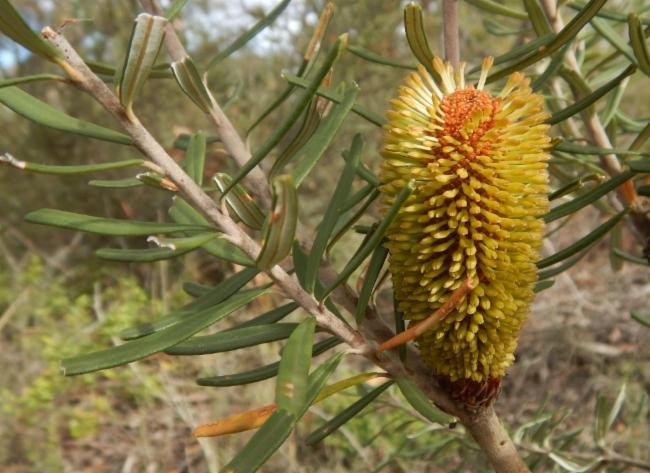Silver Banksia
(Banksia marginata)
Silver Banksia (Banksia marginata)
/
/

David Sando
CC BY 4.0
Image By:
David Sando
Recorded By:
Copyright:
CC BY 4.0
Copyright Notice:
Photo by: David Sando | License Type: CC BY 4.0 | License URL: http://creativecommons.org/licenses/by/4.0/ | Occurence ID: https://www.gbif.org/occurrence/2423553665 | Publisher: Atlas of Living Australia |
































































































































































Estimated Native Range
Summary
Banksia marginata, commonly known as the Silver Banksia, is a versatile species found throughout much of southeastern Australia, including Tasmania and Victoria. It exhibits a wide range of forms, from a small shrub of 20 centimeters to a tree reaching up to 12 meters in height. This variability is a reflection of its adaptability to different habitats, such as coastal heaths, forests, woodlands, and sub-alpine areas, where it often occupies poor, sandy soils. The Silver Banksia is notable for its serrated leaves and cylindrical flower spikes, which start yellow and fade to brown and grey as they age, eventually forming woody follicles that contain the winged seeds.
The Silver Banksia’s ability to thrive in a variety of conditions makes it a valuable plant for cultivation. It is appreciated for its distinctive foliage and architectural form, which can add texture and interest to gardens. The flowers, while not always prominent individually, can create a striking display when numerous. It is used in a range of settings, from urban landscapes to coastal gardens, and can serve as a windbreak or for erosion control. Silver Banksia requires well-drained soil and can tolerate full sun to part shade. While it can withstand drought, coastal exposure, and low temperatures, some varieties struggle with summer humidity. Propagation is typically by seed or cuttings, the latter being necessary for replicating specific forms such as dwarf varieties. It is generally low-maintenance, but gardeners should be aware of potential issues with root rot in poorly drained soils and susceptibility to Phytophthora cinnamomi, a soil-borne pathogen.
The description has been expanded to include the plant’s adaptability to different habitats and its notable foliage and flower spikes. The potential issues with summer humidity and susceptibility to Phytophthora cinnamomi have been added.CC BY-SA 4.0
The Silver Banksia’s ability to thrive in a variety of conditions makes it a valuable plant for cultivation. It is appreciated for its distinctive foliage and architectural form, which can add texture and interest to gardens. The flowers, while not always prominent individually, can create a striking display when numerous. It is used in a range of settings, from urban landscapes to coastal gardens, and can serve as a windbreak or for erosion control. Silver Banksia requires well-drained soil and can tolerate full sun to part shade. While it can withstand drought, coastal exposure, and low temperatures, some varieties struggle with summer humidity. Propagation is typically by seed or cuttings, the latter being necessary for replicating specific forms such as dwarf varieties. It is generally low-maintenance, but gardeners should be aware of potential issues with root rot in poorly drained soils and susceptibility to Phytophthora cinnamomi, a soil-borne pathogen.
The description has been expanded to include the plant’s adaptability to different habitats and its notable foliage and flower spikes. The potential issues with summer humidity and susceptibility to Phytophthora cinnamomi have been added.CC BY-SA 4.0
Plant Description
- Plant Type: Tree
- Height: 30-40 feet
- Width: 20-30 feet
- Growth Rate: Moderate
- Flower Color: Yellow
- Flowering Season: Spring, Summer
- Leaf Retention: Evergreen
Growth Requirements
- Sun: Full Sun
- Water: Medium
- Drainage: Medium, Fast
Common Uses
Bank Stabilization, Bird Garden, Drought Tolerant, Erosion Control, Hedges, Hummingbird Garden, Low Maintenance, Salt Tolerant, Street Planting
Natural Habitat
Coastal heaths, forests, woodlands, and sub-alpine areas
Other Names
Common Names: Coast Banksia
Scientific Names: , Banksia marginata, Banksia praemorsa, Banksia oblongifolia, Banksia australis, Banksia microstachya, Banksia ferrea, Banksia patula, Banksia australis var. depressa, Banksia depressa
GBIF Accepted Name: Banksia marginata Cav.